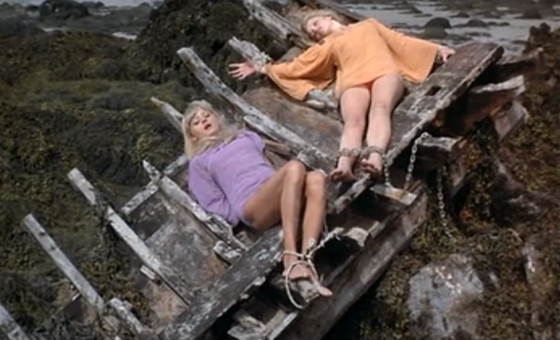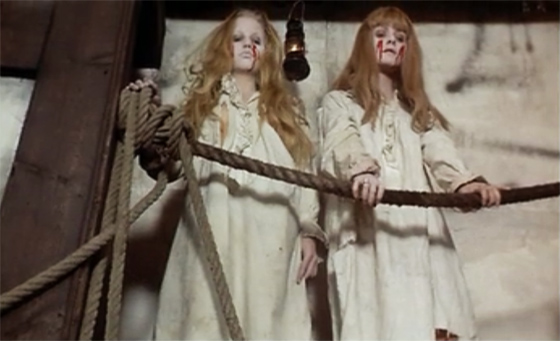
In a late-nineteenth century coastal village somewhere in Europe, a gang of land-moored pirates routinely use lights to deceive ships into wrecking upon the sharp rocks, and subsequently loot the remains. But one evening, after triumphing over their latest bounty, they see two blonde girls dressed in white nightgowns striding toward them from the sea – in the shallows, they seem to be divine, walking on water. The pirates rape and attack them. They think they’ve murdered them, but the village’s potent superstitions – that the wronged spirits of the dead might free a demon imprisoned in a nearby islet’s ancient ruins – lead them back to the crime scene. When they find the girls still scrabbling around the bones of wrecked ships, a fight and conflagration ensues. Yet the two castaways find their way to the ruins, where they encounter: a colorful clown, the long-bearded “Keeper of the Tomb,” and the mysterious man deep in its catacombs, waiting to lend his magical powers to innocents seeking revenge.
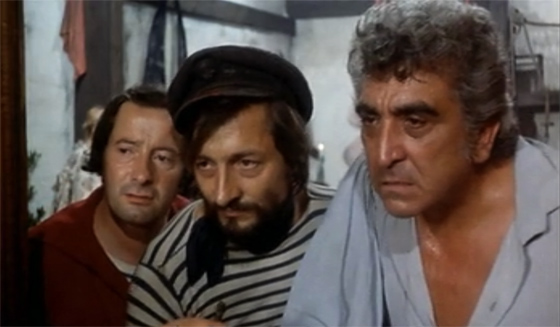
The guilt-ridden pirates: Paul (Paul Bisciglia), Bosco (Willy Braque), and the Captain (John Rico).
Even for a Jean Rollin film, The Demoniacs (Les démoniaques, 1974) is a very strange experiment. Although the setup seems straightforward, the style is so abstracted that the narrative is frequently incoherent, or deliberately absurd; a character who seems to be killed might return, perfectly healthy, a scene later. (This lends the film to a variety of interpretations, one of which is that the two girls were never alive in the first place.) Our cast seems to be stuck inside a repeating loop: rape, murder, avenge, repeat. They stumble through these actions with increasing paranoia and panic. Even when the two girls finally arrive at the island (an hour into the film) and have sex with the man in the tomb, thus gaining his mystical powers for the length of one night, that black magic is only used for a brief scene in which the girls force religious statuettes to tumble from the tops of the ruins, one crushing Demoniac‘s femme fatale. (In a Surrealist’s prankish gesture, Rollin has the figure of Jesus land upon the woman’s torso as though he were mounting her in the missionary position.) But Rollin shows his hand with the pre-credits sequence, an old-fashioned serial-styled introduction of the pirates, one at a time, as the narrator dishes out their biographies – much of which happens to be irrelevant detail. Immediately we can tell this movie isn’t meant to be taken seriously; once more Rollin is indulging his love of movie serials of the past. (Pierre Raph’s score also mimics the melodrama of old movie serials, dipping into library music for a deliberately cheesy effect.) Anyone looking for another Gothic vampire film should go elsewhere, as those overt supernatural elements which are in play are minimalized and eventually made irrelevant. That said, the film is just as erotic as those earlier films, if not more so, with nudity and sex galore, some of it on that uncomfortable-looking beach and its towering rocks.
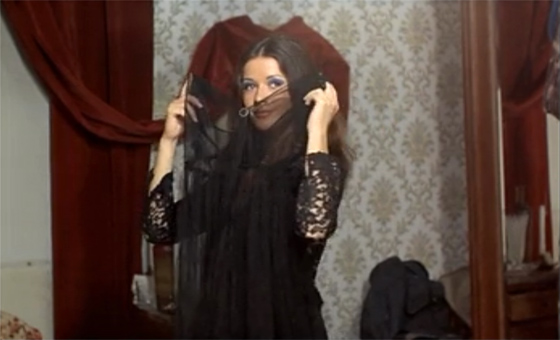
Rollin's "It" girl of '73-'74, Joëlle Coeur, plays the lusty (and frequently unclothed) pirate Tina.
Once more Rollin dips into his repertory company to fill out his cast, most notably by casting the voluptuous Joëlle Coeur, she of the Rollin softcore romps Schoolgirl Hitchhikers (Jeunes filles impudiques, 1973) and Bacchanales Sexuelles (Tout le monde il en a deux, 1974). Coeur, unlike many of her peers, resisted the pull into hardcore pornography, though her work for Rollin is decidedly uninhibited. Here, as the would-be pirate queen “Tina” (is that really the best female pirate name Rollin could muster?), Coeur is at her most animalistic, bloodthirsty – delighting as her companions rape the two castaways – and then sexually aroused by her own bloodlust. The beauty possesses the spirit of the tortured Captain (John Rico, Alex in Wonderland), who can hardly resist her charms, even as he’s driven toward hysteria as the film’s events unfold. Rico has the film’s best scene: while drinking himself into a stupor in the village saloon, he hallucinates, Macbeth-style, that blood is dripping over his hands and into his cup. When he lifts his head, he sees the ghosts of the two girls, blanched white, gazing down on him from the landing above, blood oozing from their wounds. Willy Braque, the jewel thief from Schoolgirl Hitchhikers and soon to cameo in Rollin’s superior Lips of Blood (1975), looks like Tintin‘s Captain Haddock and is quite effective as the more ruthless (and level-headed) member of the gang. I can only assume that the Castel twins weren’t available to play the two blonde victims, since the part seems tailor-made for them. Instead, these paired females, who seem to drift through all of Rollin’s films, are played by Lieva Lone and Patricia Hermenier. Their roles are more physically demanding than anything else; in one memorable scene, they crawl on their hands across a beach at night, mirrored by the white crabs scuttling next to them. Louise Dhour from Requiem for a Vampire (1972) here has a choice role as a psychic bartender. I was pleasantly surprised to see the mysterious clown revealed as none other than the moon-eyed Mireille Dargent from Requiem; however, if I were ever to encounter a clown in the ruins of a tomb, I would get the hell out of there.
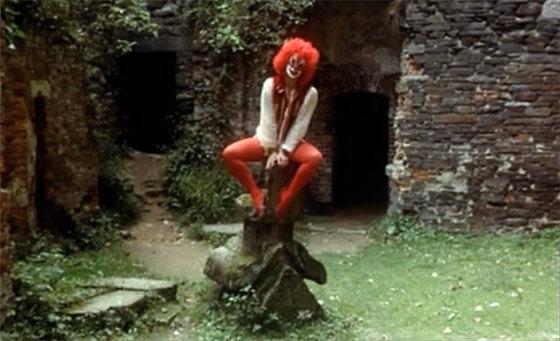
Mireille Dargent of "Requiem for a Vampire," well-disguised, plays the clown who greets visitors to the island's haunted ruins.
I wouldn’t call The Demoniacs a successful Rollin film; it’s ponderously paced (even for Rollin), and continually, even deliberately undermines its more intriguing story elements, to its own detriment. Nonetheless, it’s valuable in his filmography as a step forward toward Lips of Blood (which I’ll discuss next week), as he begins to reconcile the overt and lyrical surrealism of The Iron Rose (1973) with a more solid narrative, with the goal of creating cinema that unfolds like a waking dream. The fable-like elements at play in The Demoniacs have lots of possibilities, of which he never quite takes full advantage. Still, the landscape here is memorable, from the beach, which is decorated with shipwrecks, to the labyrinth-like island of towering ruins, like something out of Lovecraft. And here’s your chance to see what a Jean Rollin saloon looks like – with splayed bats and obscene artwork on the walls, and the same barmaids getting fondled by the same men 24/7. Say what you will about Rollin, but he was an original.
